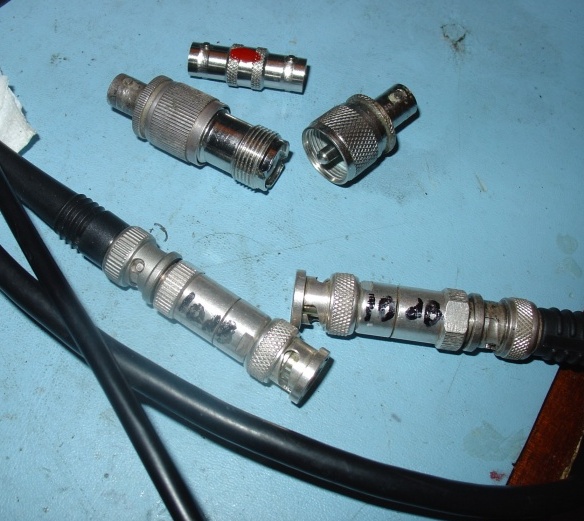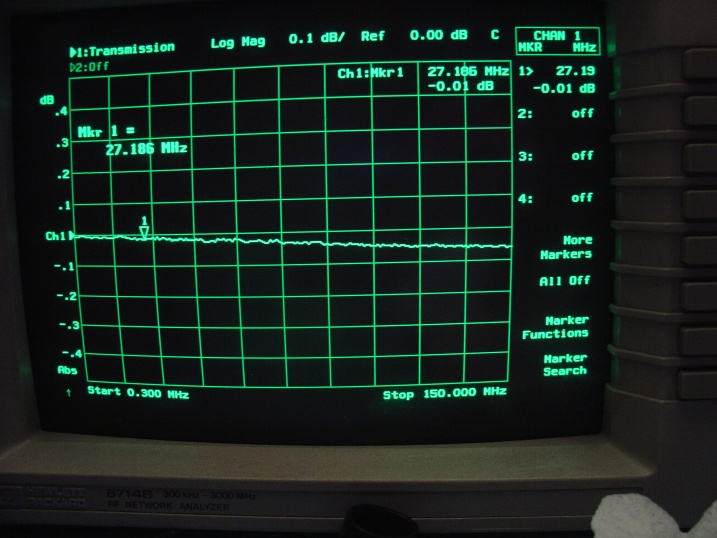Found many studies/articles about the characteristic db loss of UHF connectors (PL-259, SO-239 & barrels/double female). Depending on the source of info & assuming proper installation, it is held that the loss of a PL-259 used for 11 meters is around .1 or .2 db per connector. I need technical info, expertise or your help to identify a reliable source to determine the loss of an elbow (right angle) and double-male coax connectors. I do not want to ‘guesstimate’ by just adding the loss attributed to a PL-259 for each side of the male-male connectors.
You are using an out of date browser. It may not display this or other websites correctly.
You should upgrade or use an alternative browser.
You should upgrade or use an alternative browser.
-
You can now help support WorldwideDX when you shop on Amazon at no additional cost to you! Simply follow this Shop on Amazon link first and a portion of any purchase is sent to WorldwideDX to help with site costs.
What's the db loss on UHF elbow & male-male connectors
- Thread starter Wire Dawg
- Start date
Good luck on getting that accurate info. There is all kinds of opinions on that one.Over on QRZ the "Zed Almighty's" claim that Radio Shack barrel connectors can have 2 dB loss each and that PL-259s at least 1 dB each while Amphenol are virtually lossless. Although Amphenol are undoubtedly better if the R/S connectors were really that bad they would melt the insulation under legal limit power. The only way to know for sure is to do a return/loss measurement on the exact connectors you want to use. As for the right angle connectors I tend to avoid them, not so much because of loss but integrity. They way they go together lends itself to a higher rate of failure under high power.
For most practical purposes the loss of a good quality connector or an elbow is negligible. The only reliable way to determine the loss through your particular connector is to use proper test equipment and measure it.
If you want to put a few connectors in a box and ship to NovaScotia I'll connect them to an Agilent E5071B network analyzer and give you more information than you'd ever wanted to know. Could also connect them to some high voltage leakage testers to determine that side of things.
No one that you speak with will ever be able to tell the difference in signal level unless you do something foolish like stacking 100 of them in series. There are bigger things to worry about.
If you want to put a few connectors in a box and ship to NovaScotia I'll connect them to an Agilent E5071B network analyzer and give you more information than you'd ever wanted to know. Could also connect them to some high voltage leakage testers to determine that side of things.
No one that you speak with will ever be able to tell the difference in signal level unless you do something foolish like stacking 100 of them in series. There are bigger things to worry about.
For most practical purposes the loss of a good quality connector or an elbow is negligible. The only reliable way to determine the loss through your particular connector is to use proper test equipment and measure it.
If you want to put a few connectors in a box and ship to NovaScotia I'll connect them to an Agilent E5071B network analyzer and give you more information than you'd ever wanted to know. Could also connect them to some high voltage leakage testers to determine that side of things.
Sounds like a good idea to look at some Radio Shack stuff versus Amphenol connectors and get the REAL truth. I figure if I can't see any difference on a watt meter and there is no SWR change then things can't really be all that bad.
No one that you speak with will ever be able to tell the difference in signal level unless you do something foolish like stacking 100 of them in series. There are bigger things to worry about.
Been there and done that.
Thank you KW. Hope that luck will appear in a catalog sitting by one of our reader’s work-bench. I don’t use barrels, but I’d like to eliminate as much coax as possible by using UHF male-male connectors between radio, amp, filter and meter. Want to get db loss info before replacing jumpers, especially if there will be no benefits. The elbow may be a necessary evil because the size of the lp filter does not leave room to connect the radio.
vo1ks: If you are serious about the test, please PM me. Posting the results of well-conducted tests would be a great asset to many of our readers (present & future), as well as to increase traffic. I have not been able to find studies/ reports of db return loss for UHF elbow or male-male connectors. I'm aware that gain obtained from swapping jumpers with male-male connectors may be negligible, but it may bring about side effects such as reduction of tvi or emi.
vo1ks: If you are serious about the test, please PM me. Posting the results of well-conducted tests would be a great asset to many of our readers (present & future), as well as to increase traffic. I have not been able to find studies/ reports of db return loss for UHF elbow or male-male connectors. I'm aware that gain obtained from swapping jumpers with male-male connectors may be negligible, but it may bring about side effects such as reduction of tvi or emi.
I imagine that data has to be somewhere. Might send off some inquiries to the manufacturers tech or RD people.
Has to be a data sheet somewhere. If they sell to the government, then you know they require some kind of specs.
Has to be a data sheet somewhere. If they sell to the government, then you know they require some kind of specs.
Provided you buy a decent brand of connector I'd expect the loss on a basic straight connector to be so small at 27MHz (per connector) that you would have a tough time to measure it accurately even with modern test equipment.
eg I'd expect the loss at 27MHz to be MUCH less than 0.1dB per connector.
I'd expect it to be less than 0.02dB for a decent connector (if that helps?)
Obviously, if you buy cheapo connectors from China made from dodgy materials then all bets are off
eg I'd expect the loss at 27MHz to be MUCH less than 0.1dB per connector.
I'd expect it to be less than 0.02dB for a decent connector (if that helps?)
Obviously, if you buy cheapo connectors from China made from dodgy materials then all bets are off
I don't have many PL259 connectors here but I found a few adaptors. eg BNC to UHF and a UHF-UHF barrel.
If you look at the image below I first calibrated the VNA with the short and direct BNC to BNC adaptor (with the red blob of paint) and then I swapped it for the three UHF adaptors in series.
You can see that the loss is negligible at 27MHz.
However, this is just a hastily set up test using an old HP VNA with 5" long BNC-BNC test cables with10dB attenuators to improve the source and load match of the test equipment.
To measure losses this low with minimal uncertainty you have to ensure the source and load impedances are as close to 50R as possible.
I've not tried too hard to achieve this but I'd expect the source/load return loss at 27MHz to be 40dB or better with this setup.
So I wouldn't take the result as being very accurate but I think it's safe to assume each connector in that combo will have less than 0.02dB loss at 27MHz.


If you look at the image below I first calibrated the VNA with the short and direct BNC to BNC adaptor (with the red blob of paint) and then I swapped it for the three UHF adaptors in series.
You can see that the loss is negligible at 27MHz.
However, this is just a hastily set up test using an old HP VNA with 5" long BNC-BNC test cables with10dB attenuators to improve the source and load match of the test equipment.
To measure losses this low with minimal uncertainty you have to ensure the source and load impedances are as close to 50R as possible.
I've not tried too hard to achieve this but I'd expect the source/load return loss at 27MHz to be 40dB or better with this setup.
So I wouldn't take the result as being very accurate but I think it's safe to assume each connector in that combo will have less than 0.02dB loss at 27MHz.


Last edited:
I’d like to eliminate as much coax as possible by using UHF male-male connectors between radio, amp, filter and meter.
Be VERY careful what connectors you use in that application. Do NOT use Radio Shack connectors. I have given up on the male-male R/S connectors. They fall apart with any sideways stress. they are held together with a split ring that spreads open and allows the connector to fall into two pieces. I have had several such connectors fail the same way. Not sure what Amphenol would be like as I never had an Amphenol in that configuration but the R/S connectors are garbage. The thing I would also worry about is the added stress applied to the antenna jack on the equipment if anything gets moved or bumped. A six inch jumper would be far better in my opinion. If you worry about the extra 0.0001 dB of loss you are taking things FAR too seriously.
Last edited:
GOHZU: Thank you for sharing the results of your test. After learning that these PL-259X2 are rated at 300 watts and then finding two of them broken soon after trying them (as Captain Kilowatt mentioned, one of the rings had cracked) I had a momentary lapse of reason. I went back to the jumpers. SWR has not suffered and the meter still reads the same power output. As a side benefit, my equipment can be moved again for dusting (with the connectors it looked like a stationary Lionel train set).
Last edited:
dxChat
- No one is chatting at the moment.
-
@ Wildcat27:Hello I have a old school 2950 receives great on all modes and transmits great on AM but no transmit on SSB. Does anyone have any idea?
-
-
-
dxBot:63Sprint has left the room.
-
dxBot:kennyjames 0151 has left the room.
